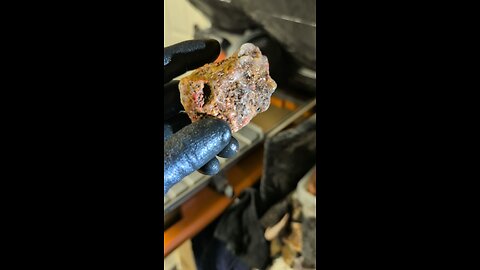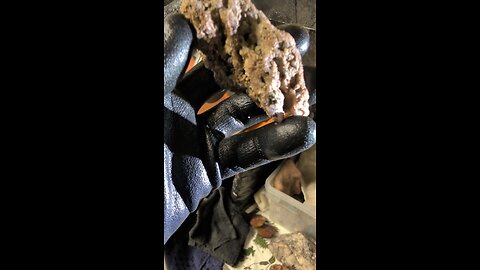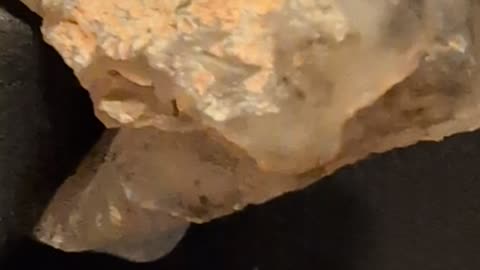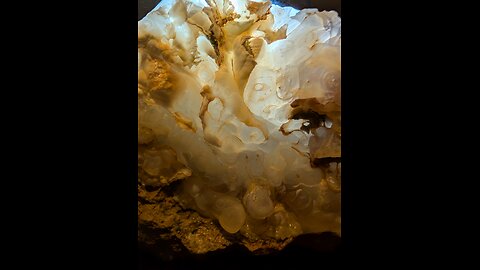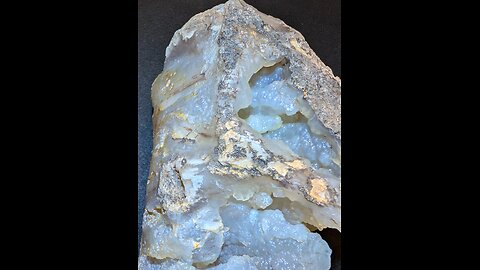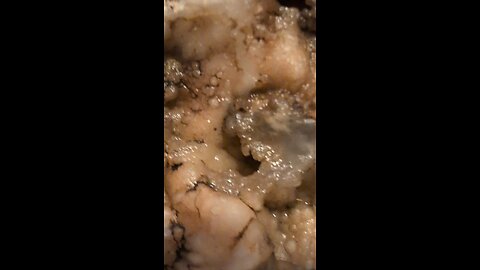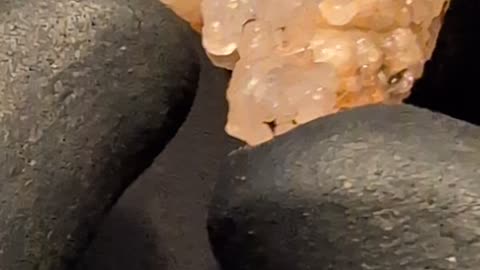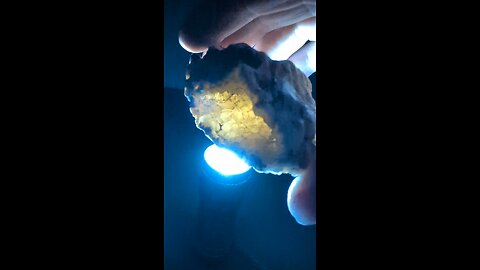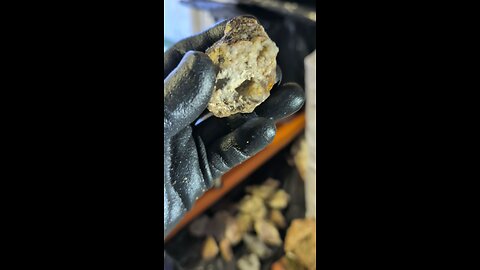
Botryoidal Formations!
23 videos
Updated 1 day ago
Minerals having a shape reminiscent of a cluster of grapes. Botryoidal crystals are formed by the slow deposition of mineral materials around a central nucleus. As more and for material is added, the surface becomes rounded and bumpy.
-
Ooids inside!
 RyanzRocksBased on the appearance of the rock in the image, it looks like it could be a type of limestone known as oolitic limestone. Oolitic limestone is characterized by its small, spherical or oval grains called ooids, which are visible in the rock's texture. These ooids are typically formed in shallow marine environments and are composed of concentric layers of calcium carbonate. The rock in the image shows a pattern of small, rounded structures embedded in a matrix, which is typical of oolitic limestone.42 views
RyanzRocksBased on the appearance of the rock in the image, it looks like it could be a type of limestone known as oolitic limestone. Oolitic limestone is characterized by its small, spherical or oval grains called ooids, which are visible in the rock's texture. These ooids are typically formed in shallow marine environments and are composed of concentric layers of calcium carbonate. The rock in the image shows a pattern of small, rounded structures embedded in a matrix, which is typical of oolitic limestone.42 views -
Brecciated Jasper Cut!
 RyanzRocksBrecciated Jasper is a type of jasper that is characterized by its appearance as broken fragments or pieces of jasper that have been naturally cemented together. Here's a more detailed explanation: Formation: Brecciated Jasper forms when existing jasper is fractured or broken into pieces due to geological processes like tectonic activity or weathering. These fragments are then cemented together by silica or other minerals, often quartz, which fills the spaces between the fragments. Appearance: It typically has a distinctive, mosaic-like pattern where the jasper fragments are angular and vary in size, creating a visually striking contrast with the matrix that holds them together. The colors can range from red, brown, yellow, to white, depending on the impurities present in the jasper and the matrix material. Uses: Due to its unique and attractive pattern, Brecciated Jasper is commonly used in jewelry, carvings, and decorative items. It's valued for its aesthetic appeal and the interesting geological story it tells. Properties: Like other types of jasper, Brecciated Jasper is relatively hard (around 6.5 to 7 on the Mohs scale), making it durable for various uses. It also has a waxy to vitreous luster when polished. This type of jasper not only adds beauty to various crafts but also provides insight into the geological processes that have shaped our planet.30 views
RyanzRocksBrecciated Jasper is a type of jasper that is characterized by its appearance as broken fragments or pieces of jasper that have been naturally cemented together. Here's a more detailed explanation: Formation: Brecciated Jasper forms when existing jasper is fractured or broken into pieces due to geological processes like tectonic activity or weathering. These fragments are then cemented together by silica or other minerals, often quartz, which fills the spaces between the fragments. Appearance: It typically has a distinctive, mosaic-like pattern where the jasper fragments are angular and vary in size, creating a visually striking contrast with the matrix that holds them together. The colors can range from red, brown, yellow, to white, depending on the impurities present in the jasper and the matrix material. Uses: Due to its unique and attractive pattern, Brecciated Jasper is commonly used in jewelry, carvings, and decorative items. It's valued for its aesthetic appeal and the interesting geological story it tells. Properties: Like other types of jasper, Brecciated Jasper is relatively hard (around 6.5 to 7 on the Mohs scale), making it durable for various uses. It also has a waxy to vitreous luster when polished. This type of jasper not only adds beauty to various crafts but also provides insight into the geological processes that have shaped our planet.30 views -
Botryoidal Plume Cut!
 RyanzRocksPlume agate is a distinctive variety of agate, known for its unique and intricate patterns that resemble plumes, feathers, or even landscapes. Here are some key points about plume agate: Formation: Plume agate forms when silica-rich solutions seep into cavities in volcanic rocks. The "plumes" are created by manganese or iron oxides that get trapped in the silica, forming these feather-like patterns. Colors: The colors of plume agate can vary widely depending on the minerals present. Common colors include reds, browns, yellows, blacks, and whites, with the plumes often contrasting against the base color of the agate. Locations: Notable locations where plume agate is found include Oregon in the United States (specifically, the Owyhee Mountain area), Mexico, and Brazil. Each location can produce agates with unique characteristics. Uses: Plume agate is popular among collectors and is often used in jewelry like pendants, rings, and beads due to its aesthetic appeal. It's also valued in metaphysical communities, where it's believed to enhance one's connection to the Earth, promote creativity, and aid in grounding. Care: Like other agates, plume agate is relatively hard (about 6.5-7 on the Mohs scale), making it durable for jewelry. However, it should be protected from sharp blows or extreme temperature changes to avoid cracking. Identification: When identifying plume agate, look for the characteristic plume-like inclusions. These inclusions should appear as if they are floating within the stone, giving a 3D effect when viewed from different angles. Plume agate's beauty lies in its natural patterns, which can look like trees, clouds, or even abstract art, making each piece unique.26 views
RyanzRocksPlume agate is a distinctive variety of agate, known for its unique and intricate patterns that resemble plumes, feathers, or even landscapes. Here are some key points about plume agate: Formation: Plume agate forms when silica-rich solutions seep into cavities in volcanic rocks. The "plumes" are created by manganese or iron oxides that get trapped in the silica, forming these feather-like patterns. Colors: The colors of plume agate can vary widely depending on the minerals present. Common colors include reds, browns, yellows, blacks, and whites, with the plumes often contrasting against the base color of the agate. Locations: Notable locations where plume agate is found include Oregon in the United States (specifically, the Owyhee Mountain area), Mexico, and Brazil. Each location can produce agates with unique characteristics. Uses: Plume agate is popular among collectors and is often used in jewelry like pendants, rings, and beads due to its aesthetic appeal. It's also valued in metaphysical communities, where it's believed to enhance one's connection to the Earth, promote creativity, and aid in grounding. Care: Like other agates, plume agate is relatively hard (about 6.5-7 on the Mohs scale), making it durable for jewelry. However, it should be protected from sharp blows or extreme temperature changes to avoid cracking. Identification: When identifying plume agate, look for the characteristic plume-like inclusions. These inclusions should appear as if they are floating within the stone, giving a 3D effect when viewed from different angles. Plume agate's beauty lies in its natural patterns, which can look like trees, clouds, or even abstract art, making each piece unique.26 views -
Plume botryoidal chalcedony nugget!
 RyanzRocksPlume Agate is a captivating variety of agate, renowned for its intricate and delicate feather-like inclusions. These mesmerizing formations resemble ethereal plumes or wisps suspended within the stone, creating a stunning visual effect. It belongs to the chalcedony family, characterized by its microcrystalline structure and vibrant colors. Plume Agate derives its name from the feathery patterns that adorn its surface. These patterns are typically composed of mineral deposits, often in striking hues such as white, cream, pink, or red, contrasting against a translucent or opaque background. These intricate formations are formed through the slow crystallization of silica-rich solutions within cavities or fissures in volcanic rocks. Each piece of Plume Agate is unique, showcasing a kaleidoscope of colors and patterns. The delicate plumes within the stone evoke a sense of tranquility and beauty, making it a highly sought-after gemstone among collectors and jewelry enthusiasts alike. Plume Agate holds significant importance in the world of gemstones and jewelry for several reasons: Aesthetic Appeal: Plume Agate’s captivating patterns and vibrant colors make it a favorite among jewelry designers and collectors. Its unique beauty adds an element of elegance and individuality to any piece of jewelry. Metaphysical Properties: In addition to its visual allure, Plume Agate is believed to possess metaphysical properties that promote harmony, balance, and emotional healing. It is often used in alternative healing practices and spiritual rituals. Collectibility: Due to its rarity and unique characteristics, Plume Agate is highly prized by gemstone collectors. Specimens with exceptional plume formations or intense colors can command high prices in the market. Versatility: Plume Agate’s diverse color palette and patterns make it a versatile gemstone for jewelry design. It can be fashioned into various shapes and sizes, including cabochons, beads, and carvings, allowing for creativity and innovation in jewelry making. Historical Significance: Throughout history, agates have been revered for their beauty and perceived mystical properties. Plume Agate, with its distinct plume-like inclusions, has been admired and utilized in adornments and talismans by ancient civilizations. Plume Agate stands out as a gemstone of exceptional beauty, imbued with both aesthetic and metaphysical significance. Its popularity in the world of gemstones and jewelry continues to endure, captivating admirers with its mesmerizing patterns and timeless allure. - https://geologyscience.com/gemstone/plume-agate/25 views
RyanzRocksPlume Agate is a captivating variety of agate, renowned for its intricate and delicate feather-like inclusions. These mesmerizing formations resemble ethereal plumes or wisps suspended within the stone, creating a stunning visual effect. It belongs to the chalcedony family, characterized by its microcrystalline structure and vibrant colors. Plume Agate derives its name from the feathery patterns that adorn its surface. These patterns are typically composed of mineral deposits, often in striking hues such as white, cream, pink, or red, contrasting against a translucent or opaque background. These intricate formations are formed through the slow crystallization of silica-rich solutions within cavities or fissures in volcanic rocks. Each piece of Plume Agate is unique, showcasing a kaleidoscope of colors and patterns. The delicate plumes within the stone evoke a sense of tranquility and beauty, making it a highly sought-after gemstone among collectors and jewelry enthusiasts alike. Plume Agate holds significant importance in the world of gemstones and jewelry for several reasons: Aesthetic Appeal: Plume Agate’s captivating patterns and vibrant colors make it a favorite among jewelry designers and collectors. Its unique beauty adds an element of elegance and individuality to any piece of jewelry. Metaphysical Properties: In addition to its visual allure, Plume Agate is believed to possess metaphysical properties that promote harmony, balance, and emotional healing. It is often used in alternative healing practices and spiritual rituals. Collectibility: Due to its rarity and unique characteristics, Plume Agate is highly prized by gemstone collectors. Specimens with exceptional plume formations or intense colors can command high prices in the market. Versatility: Plume Agate’s diverse color palette and patterns make it a versatile gemstone for jewelry design. It can be fashioned into various shapes and sizes, including cabochons, beads, and carvings, allowing for creativity and innovation in jewelry making. Historical Significance: Throughout history, agates have been revered for their beauty and perceived mystical properties. Plume Agate, with its distinct plume-like inclusions, has been admired and utilized in adornments and talismans by ancient civilizations. Plume Agate stands out as a gemstone of exceptional beauty, imbued with both aesthetic and metaphysical significance. Its popularity in the world of gemstones and jewelry continues to endure, captivating admirers with its mesmerizing patterns and timeless allure. - https://geologyscience.com/gemstone/plume-agate/25 views -
Plume slice!
 RyanzRocksPlume Agate is a captivating variety of agate, renowned for its intricate and delicate feather-like inclusions. These mesmerizing formations resemble ethereal plumes or wisps suspended within the stone, creating a stunning visual effect. It belongs to the chalcedony family, characterized by its microcrystalline structure and vibrant colors. Plume Agate derives its name from the feathery patterns that adorn its surface. These patterns are typically composed of mineral deposits, often in striking hues such as white, cream, pink, or red, contrasting against a translucent or opaque background. These intricate formations are formed through the slow crystallization of silica-rich solutions within cavities or fissures in volcanic rocks. Each piece of Plume Agate is unique, showcasing a kaleidoscope of colors and patterns. The delicate plumes within the stone evoke a sense of tranquility and beauty, making it a highly sought-after gemstone among collectors and jewelry enthusiasts alike. Plume Agate holds significant importance in the world of gemstones and jewelry for several reasons: Aesthetic Appeal: Plume Agate’s captivating patterns and vibrant colors make it a favorite among jewelry designers and collectors. Its unique beauty adds an element of elegance and individuality to any piece of jewelry. Metaphysical Properties: In addition to its visual allure, Plume Agate is believed to possess metaphysical properties that promote harmony, balance, and emotional healing. It is often used in alternative healing practices and spiritual rituals. Collectibility: Due to its rarity and unique characteristics, Plume Agate is highly prized by gemstone collectors. Specimens with exceptional plume formations or intense colors can command high prices in the market. Versatility: Plume Agate’s diverse color palette and patterns make it a versatile gemstone for jewelry design. It can be fashioned into various shapes and sizes, including cabochons, beads, and carvings, allowing for creativity and innovation in jewelry making. Historical Significance: Throughout history, agates have been revered for their beauty and perceived mystical properties. Plume Agate, with its distinct plume-like inclusions, has been admired and utilized in adornments and talismans by ancient civilizations. Plume Agate stands out as a gemstone of exceptional beauty, imbued with both aesthetic and metaphysical significance. Its popularity in the world of gemstones and jewelry continues to endure, captivating admirers with its mesmerizing patterns and timeless allure. - https://geologyscience.com/gemstone/plume-agate/28 views
RyanzRocksPlume Agate is a captivating variety of agate, renowned for its intricate and delicate feather-like inclusions. These mesmerizing formations resemble ethereal plumes or wisps suspended within the stone, creating a stunning visual effect. It belongs to the chalcedony family, characterized by its microcrystalline structure and vibrant colors. Plume Agate derives its name from the feathery patterns that adorn its surface. These patterns are typically composed of mineral deposits, often in striking hues such as white, cream, pink, or red, contrasting against a translucent or opaque background. These intricate formations are formed through the slow crystallization of silica-rich solutions within cavities or fissures in volcanic rocks. Each piece of Plume Agate is unique, showcasing a kaleidoscope of colors and patterns. The delicate plumes within the stone evoke a sense of tranquility and beauty, making it a highly sought-after gemstone among collectors and jewelry enthusiasts alike. Plume Agate holds significant importance in the world of gemstones and jewelry for several reasons: Aesthetic Appeal: Plume Agate’s captivating patterns and vibrant colors make it a favorite among jewelry designers and collectors. Its unique beauty adds an element of elegance and individuality to any piece of jewelry. Metaphysical Properties: In addition to its visual allure, Plume Agate is believed to possess metaphysical properties that promote harmony, balance, and emotional healing. It is often used in alternative healing practices and spiritual rituals. Collectibility: Due to its rarity and unique characteristics, Plume Agate is highly prized by gemstone collectors. Specimens with exceptional plume formations or intense colors can command high prices in the market. Versatility: Plume Agate’s diverse color palette and patterns make it a versatile gemstone for jewelry design. It can be fashioned into various shapes and sizes, including cabochons, beads, and carvings, allowing for creativity and innovation in jewelry making. Historical Significance: Throughout history, agates have been revered for their beauty and perceived mystical properties. Plume Agate, with its distinct plume-like inclusions, has been admired and utilized in adornments and talismans by ancient civilizations. Plume Agate stands out as a gemstone of exceptional beauty, imbued with both aesthetic and metaphysical significance. Its popularity in the world of gemstones and jewelry continues to endure, captivating admirers with its mesmerizing patterns and timeless allure. - https://geologyscience.com/gemstone/plume-agate/28 views -
Botryoidal slice!
 RyanzRocksPlume Agate is a captivating variety of agate, renowned for its intricate and delicate feather-like inclusions. These mesmerizing formations resemble ethereal plumes or wisps suspended within the stone, creating a stunning visual effect. It belongs to the chalcedony family, characterized by its microcrystalline structure and vibrant colors. Plume Agate derives its name from the feathery patterns that adorn its surface. These patterns are typically composed of mineral deposits, often in striking hues such as white, cream, pink, or red, contrasting against a translucent or opaque background. These intricate formations are formed through the slow crystallization of silica-rich solutions within cavities or fissures in volcanic rocks. Each piece of Plume Agate is unique, showcasing a kaleidoscope of colors and patterns. The delicate plumes within the stone evoke a sense of tranquility and beauty, making it a highly sought-after gemstone among collectors and jewelry enthusiasts alike. Plume Agate holds significant importance in the world of gemstones and jewelry for several reasons: Aesthetic Appeal: Plume Agate’s captivating patterns and vibrant colors make it a favorite among jewelry designers and collectors. Its unique beauty adds an element of elegance and individuality to any piece of jewelry. Metaphysical Properties: In addition to its visual allure, Plume Agate is believed to possess metaphysical properties that promote harmony, balance, and emotional healing. It is often used in alternative healing practices and spiritual rituals. Collectibility: Due to its rarity and unique characteristics, Plume Agate is highly prized by gemstone collectors. Specimens with exceptional plume formations or intense colors can command high prices in the market. Versatility: Plume Agate’s diverse color palette and patterns make it a versatile gemstone for jewelry design. It can be fashioned into various shapes and sizes, including cabochons, beads, and carvings, allowing for creativity and innovation in jewelry making. Historical Significance: Throughout history, agates have been revered for their beauty and perceived mystical properties. Plume Agate, with its distinct plume-like inclusions, has been admired and utilized in adornments and talismans by ancient civilizations. Plume Agate stands out as a gemstone of exceptional beauty, imbued with both aesthetic and metaphysical significance. Its popularity in the world of gemstones and jewelry continues to endure, captivating admirers with its mesmerizing patterns and timeless allure. - https://geologyscience.com/gemstone/plume-agate/33 views
RyanzRocksPlume Agate is a captivating variety of agate, renowned for its intricate and delicate feather-like inclusions. These mesmerizing formations resemble ethereal plumes or wisps suspended within the stone, creating a stunning visual effect. It belongs to the chalcedony family, characterized by its microcrystalline structure and vibrant colors. Plume Agate derives its name from the feathery patterns that adorn its surface. These patterns are typically composed of mineral deposits, often in striking hues such as white, cream, pink, or red, contrasting against a translucent or opaque background. These intricate formations are formed through the slow crystallization of silica-rich solutions within cavities or fissures in volcanic rocks. Each piece of Plume Agate is unique, showcasing a kaleidoscope of colors and patterns. The delicate plumes within the stone evoke a sense of tranquility and beauty, making it a highly sought-after gemstone among collectors and jewelry enthusiasts alike. Plume Agate holds significant importance in the world of gemstones and jewelry for several reasons: Aesthetic Appeal: Plume Agate’s captivating patterns and vibrant colors make it a favorite among jewelry designers and collectors. Its unique beauty adds an element of elegance and individuality to any piece of jewelry. Metaphysical Properties: In addition to its visual allure, Plume Agate is believed to possess metaphysical properties that promote harmony, balance, and emotional healing. It is often used in alternative healing practices and spiritual rituals. Collectibility: Due to its rarity and unique characteristics, Plume Agate is highly prized by gemstone collectors. Specimens with exceptional plume formations or intense colors can command high prices in the market. Versatility: Plume Agate’s diverse color palette and patterns make it a versatile gemstone for jewelry design. It can be fashioned into various shapes and sizes, including cabochons, beads, and carvings, allowing for creativity and innovation in jewelry making. Historical Significance: Throughout history, agates have been revered for their beauty and perceived mystical properties. Plume Agate, with its distinct plume-like inclusions, has been admired and utilized in adornments and talismans by ancient civilizations. Plume Agate stands out as a gemstone of exceptional beauty, imbued with both aesthetic and metaphysical significance. Its popularity in the world of gemstones and jewelry continues to endure, captivating admirers with its mesmerizing patterns and timeless allure. - https://geologyscience.com/gemstone/plume-agate/33 views -
Plume agate inspection!
 RyanzRocksPlume Agate is a captivating variety of agate, renowned for its intricate and delicate feather-like inclusions. These mesmerizing formations resemble ethereal plumes or wisps suspended within the stone, creating a stunning visual effect. It belongs to the chalcedony family, characterized by its microcrystalline structure and vibrant colors. Plume Agate derives its name from the feathery patterns that adorn its surface. These patterns are typically composed of mineral deposits, often in striking hues such as white, cream, pink, or red, contrasting against a translucent or opaque background. These intricate formations are formed through the slow crystallization of silica-rich solutions within cavities or fissures in volcanic rocks. Each piece of Plume Agate is unique, showcasing a kaleidoscope of colors and patterns. The delicate plumes within the stone evoke a sense of tranquility and beauty, making it a highly sought-after gemstone among collectors and jewelry enthusiasts alike. Plume Agate holds significant importance in the world of gemstones and jewelry for several reasons: Aesthetic Appeal: Plume Agate’s captivating patterns and vibrant colors make it a favorite among jewelry designers and collectors. Its unique beauty adds an element of elegance and individuality to any piece of jewelry. Metaphysical Properties: In addition to its visual allure, Plume Agate is believed to possess metaphysical properties that promote harmony, balance, and emotional healing. It is often used in alternative healing practices and spiritual rituals. Collectibility: Due to its rarity and unique characteristics, Plume Agate is highly prized by gemstone collectors. Specimens with exceptional plume formations or intense colors can command high prices in the market. Versatility: Plume Agate’s diverse color palette and patterns make it a versatile gemstone for jewelry design. It can be fashioned into various shapes and sizes, including cabochons, beads, and carvings, allowing for creativity and innovation in jewelry making. Historical Significance: Throughout history, agates have been revered for their beauty and perceived mystical properties. Plume Agate, with its distinct plume-like inclusions, has been admired and utilized in adornments and talismans by ancient civilizations. Plume Agate stands out as a gemstone of exceptional beauty, imbued with both aesthetic and metaphysical significance. Its popularity in the world of gemstones and jewelry continues to endure, captivating admirers with its mesmerizing patterns and timeless allure. - https://geologyscience.com/gemstone/plume-agate/27 views
RyanzRocksPlume Agate is a captivating variety of agate, renowned for its intricate and delicate feather-like inclusions. These mesmerizing formations resemble ethereal plumes or wisps suspended within the stone, creating a stunning visual effect. It belongs to the chalcedony family, characterized by its microcrystalline structure and vibrant colors. Plume Agate derives its name from the feathery patterns that adorn its surface. These patterns are typically composed of mineral deposits, often in striking hues such as white, cream, pink, or red, contrasting against a translucent or opaque background. These intricate formations are formed through the slow crystallization of silica-rich solutions within cavities or fissures in volcanic rocks. Each piece of Plume Agate is unique, showcasing a kaleidoscope of colors and patterns. The delicate plumes within the stone evoke a sense of tranquility and beauty, making it a highly sought-after gemstone among collectors and jewelry enthusiasts alike. Plume Agate holds significant importance in the world of gemstones and jewelry for several reasons: Aesthetic Appeal: Plume Agate’s captivating patterns and vibrant colors make it a favorite among jewelry designers and collectors. Its unique beauty adds an element of elegance and individuality to any piece of jewelry. Metaphysical Properties: In addition to its visual allure, Plume Agate is believed to possess metaphysical properties that promote harmony, balance, and emotional healing. It is often used in alternative healing practices and spiritual rituals. Collectibility: Due to its rarity and unique characteristics, Plume Agate is highly prized by gemstone collectors. Specimens with exceptional plume formations or intense colors can command high prices in the market. Versatility: Plume Agate’s diverse color palette and patterns make it a versatile gemstone for jewelry design. It can be fashioned into various shapes and sizes, including cabochons, beads, and carvings, allowing for creativity and innovation in jewelry making. Historical Significance: Throughout history, agates have been revered for their beauty and perceived mystical properties. Plume Agate, with its distinct plume-like inclusions, has been admired and utilized in adornments and talismans by ancient civilizations. Plume Agate stands out as a gemstone of exceptional beauty, imbued with both aesthetic and metaphysical significance. Its popularity in the world of gemstones and jewelry continues to endure, captivating admirers with its mesmerizing patterns and timeless allure. - https://geologyscience.com/gemstone/plume-agate/27 views -
Botryoidal Chalcedony Nugget!
 RyanzRocksChalcedony, a microcrystalline variety of quartz. It forms in concentric layers within cavities of rocks, typically igneous rocks such as volcanic basalt. Botryoidal agate forms when layers of silica-rich fluids deposit successive layers of chalcedony around a central nucleus, creating these distinctive rounded shapes. One of the most intriguing aspects of botryoidal agate is its diverse range of colors and patterns. These patterns are often accentuated by the unique banding and translucency inherent to agate. From vibrant hues of blue, green, and purple to earthy tones of brown and gray, each specimen showcases its own distinct beauty.23 views 1 comment
RyanzRocksChalcedony, a microcrystalline variety of quartz. It forms in concentric layers within cavities of rocks, typically igneous rocks such as volcanic basalt. Botryoidal agate forms when layers of silica-rich fluids deposit successive layers of chalcedony around a central nucleus, creating these distinctive rounded shapes. One of the most intriguing aspects of botryoidal agate is its diverse range of colors and patterns. These patterns are often accentuated by the unique banding and translucency inherent to agate. From vibrant hues of blue, green, and purple to earthy tones of brown and gray, each specimen showcases its own distinct beauty.23 views 1 comment -
Botryoidal Glow!
 RyanzRocksThis rock appears to be an example of an open geode. Geodes are typically characterized by their hollow or partially hollow interiors, which are often lined with crystals or minerals. Here's why: Texture and Appearance: The rock in the image has a rough exterior with a somewhat nodular surface, which is typical for geodes. The interior seems to contain a liquid or a crystalline substance, which is consistent with the internal structure of many geodes. Possible Mineral Content: The yellowish-brown coloration and the appearance of liquid or crystalline material suggest the presence of minerals like quartz or calcite, which are common in geodes. Formation: Geodes form when gas bubbles are trapped in volcanic rocks or sedimentary layers. Over time, minerals precipitate from water seeping through the rock, lining the cavity with crystals.27 views
RyanzRocksThis rock appears to be an example of an open geode. Geodes are typically characterized by their hollow or partially hollow interiors, which are often lined with crystals or minerals. Here's why: Texture and Appearance: The rock in the image has a rough exterior with a somewhat nodular surface, which is typical for geodes. The interior seems to contain a liquid or a crystalline substance, which is consistent with the internal structure of many geodes. Possible Mineral Content: The yellowish-brown coloration and the appearance of liquid or crystalline material suggest the presence of minerals like quartz or calcite, which are common in geodes. Formation: Geodes form when gas bubbles are trapped in volcanic rocks or sedimentary layers. Over time, minerals precipitate from water seeping through the rock, lining the cavity with crystals.27 views -
Hot Botryoidal Mess!
 RyanzRocksPlume agate is a variety of chalcedony, a microcrystalline quartz, characterized by delicate, plume-like inclusions of various colors and minerals. These inclusions often resemble feathers, flowers, or flames, giving the agate a unique and visually appealing appearance. Plume agate only forms in hotsprings with the help of thermophiles and extremophiles (microscopic organisms that like harsh and hot environments) collecting silica and other dissolved particles in silica rich hotsprings and depositing them in wild patterns within the agate. A combination of clays, metals and minerals make up the cool colors and textures we experience. There are many famous deposits of plume, flame and other varieties of textures made with the assistance of microbes.12 views
RyanzRocksPlume agate is a variety of chalcedony, a microcrystalline quartz, characterized by delicate, plume-like inclusions of various colors and minerals. These inclusions often resemble feathers, flowers, or flames, giving the agate a unique and visually appealing appearance. Plume agate only forms in hotsprings with the help of thermophiles and extremophiles (microscopic organisms that like harsh and hot environments) collecting silica and other dissolved particles in silica rich hotsprings and depositing them in wild patterns within the agate. A combination of clays, metals and minerals make up the cool colors and textures we experience. There are many famous deposits of plume, flame and other varieties of textures made with the assistance of microbes.12 views
